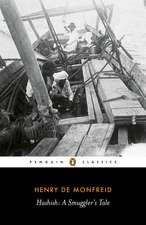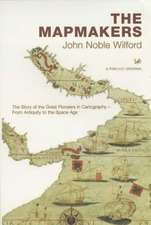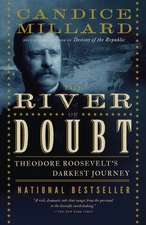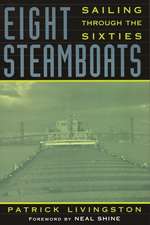Irresistible North: From Venice to Greenland on the Trail of the Zen Brothers
Autor Andrea Di Robilanten Limba Engleză Paperback – 6 aug 2012
In this very original work—part history, part travelogue—Andrea di Robilant chronicles his discovery of a travel narrative published in 1558 by the Venetian statesman Nicolò Zen. The text and its fascinating nautical map re-created the travels of two of the author’s ancestors, brothers who claimed to have explored the North Atlantic in the 1380s and 1390s. Di Robilant sets out to discover why the Zens’ account later came under attack as one of the greatest frauds in geographical history. Was their map—and even their journey—partially or perhaps entirely faked?
Preț: 104.36 lei
Nou
Puncte Express: 157
Preț estimativ în valută:
19.97€ • 20.77$ • 16.49£
19.97€ • 20.77$ • 16.49£
Carte disponibilă
Livrare economică 24 martie-07 aprilie
Preluare comenzi: 021 569.72.76
Specificații
ISBN-13: 9780307390660
ISBN-10: 0307390667
Pagini: 228
Ilustrații: 20 ILLUSTRATIONS IN TEXT
Dimensiuni: 130 x 201 x 20 mm
Greutate: 0.18 kg
Editura: VINTAGE BOOKS
ISBN-10: 0307390667
Pagini: 228
Ilustrații: 20 ILLUSTRATIONS IN TEXT
Dimensiuni: 130 x 201 x 20 mm
Greutate: 0.18 kg
Editura: VINTAGE BOOKS
Notă biografică
Andrea di Robilant was born in Italy and educated at Columbia University, where he specialized in international affairs. He is the author of two previous books, A Venetian Affair and Lucia: A Venetian Life in the Age of Napoleon. He currently lives in Rome with his wife and two sons.
Extras
From the Prologue
I came upon this curious map in the most unexpected way. One day I was reading in the Biblioteca Marciana, in Venice, when an American tourist in shorts and T-shirt wandered into the hall holding a crumpled piece of paper. I offered to help as he was having some difficulty making himself understood by the clerk. He said he came from Madison, a small coastal town in Connecticut; he was on a pilgrimage to see the family palazzo of two Venetian brothers he claimed had crossed the Atlantic and reached the coast of North America at the end of the fourteenth century. He handed over the note on which he had scribbled their names: Nicolò and Antonio Zen. They meant nothing to me at the time and the story sounded rather outlandish, but as the American was in a hurry to rejoin the group he was with, I pulled out from the open stacks a book on Venetian palaces, showed him a picture of a Palazzo Zen near the Frari Church and sent him on his way.
There are several Zen palaces in Venice: a few days later I was walking down the Fondamenta Santa Caterina, off the Campo dei Gesuiti (a brisk twenty-minute walk from the Frari), when I noticed a soot-covered plaque on the wall of a crumbling building:
A
Nicolò e Antonio Zen
nel secolo decimoquarto
navigatori sapientemente arditi
dei mari nordici*
(* “To Nicolò and Antonio Zen, wise and courageous navigators to the northern seas in the fourteenth century.”)
So this was the Palazzo Zen the American was looking for! It had none of the majesty of the great palaces that line the Grand Canal. Tufts of weeds tumbled out of the cracks in the marble. Loose electrical wires dangled from on high. Steel beams supported the walls like rusty old crutches. Even by Venetian standards, the building looked terribly worn. Yet the unusual mix of Gothic and Renaissance styles, embellished by Levantine motifs, gave it an air of shabby grandeur.
The next day, I put aside my research and checked the library catalog to see if I could find a reference to the Zen brothers and their mysterious voyages. Out of the Rare Book Collection came a dusty little volume, six inches by four, that seemed to have traveled to my desk straight from a sixteenth-century Venetian bookshop.
The book was printed in 1558 by a certain Francesco Marcolini. It was a travel narrative written in Italian, which was unusual because Latin was still the language of choice in publishing. The title was long-winded but alluring: Dello scoprimento dell’isole Frislanda, Eslanda, Engrovelanda, Estotilanda & Icaria fatto sotto il Polo Artico da due fratelli Zeni (On the Discovery of the Islands of Frislanda, Eslanda, Engrovelanda, Estotilanda and Icaria made by two Zen brothers under the Arctic Pole).
The name of the author was not on the cover, but Marcolini, the printer, explained in the introduction that the book was written by “the Magnificent M. Nicolò Zen,” a great-great-great-grandson of Antonio Zen, one of the two navigators. This Nicolò Zen, whom I shall henceforth call Nicolò the Younger to avoid confusion with his ancestor, was a well-respected statesman in Renaissance Venice and a minor historian whom I’d come across on several occasions during my studies at the Biblioteca Marciana. The book, he claimed, was based on several damaged letters the brothers had sent home during their travels in the 1380s and 1390s, and which had remained in the family archives ever since.
Glued to the back of the little volume was a Carta da navegar—a nautical map. (For an enlargement of this map, see the final page of this book.) It was a wood-engraving with a rich, grainy texture. At first glance it looked like the sketch of an old treasure map, with oddly shaped islands and exotic place names. But I recognized the coastline of Scandinavia. The Shetland Islands were placed a little too close to the Norwegian coast. Iceland was roughly where it should have been, although a cluster of mysterious islets had been sprinkled along its eastern coast. Greenland’s outline was traced with startling precision, but then a lumpy Nova Scotia seemed to have lost its bearings and was floating eastward, away from Newfoundland and the coast of New England. Strangest of all was a large, bulky island called Frisland (Fris- landa in the text of the book), which the author placed above Scotland.
Even more intriguing than these obvious distortions was the general configuration of the map. It showed the North Atlantic as a semi-enclosed sea, in some ways a mirror image of the Mediterranean, and not as a wide-open expanse of water between two continents. Although the map was in many respects rather advanced by Renaissance standards—especially with regard to Greenland—it seemed to reflect a late-medieval view of the North Atlantic in that it did not take into account the new geographical discoveries that, from 1492 onward, had revealed to Europeans the existence of the American landmass.
Travel narrative was very popular in the sixteenth century and the book sold well. After some initial probing I learned that several editions appeared in Venice in the following years. One of them reached Gerard Mercator, the great cartographer, in the German town of Duisburg; he used the Zens’ Carta da navegar to complete the first modern map of the world in 1569. An English translation was published in London by Richard Hakluyt, an influential geographer in Elizabethan England. Later I discovered that John Dee, astrologer, mathematician and close advisor to Queen Elizabeth I, seized on the Zen voyages in the 1570s to press the case for a British empire in North America. The Crown even sent Martin Frobisher on a fruitless journey to discover Frislanda and claim it for England.
As cartography became more accurate, the Zen map, like all maps of its period, lost much of its relevance. The book, on the other hand, continued to be read well into the nineteenth century. But in 1835 a Danish admiral, Christian Zahrtmann, stunned the world of geographers and map- makers by declaring it was nothing but “a tissue of fiction” and that Nicolò the Younger, the author, was a mischievous fablemonger. It took forty years for the Royal Geographical Society to publish a rebuttal of Admiral Zahrtmann’s accusations; it was penned by Richard Henry Major, one of its most prestigious members. But the stain of forgery proved indelible. The book suffered several more attacks and by the end of the nineteenth century it had been fairly torn to shreds, a critic pronouncing it “one of the most successful and obnoxious [literary frauds] on record.”
The Zen brothers faded into oblivion. There is not a trace of them in contemporary books about travel and discovery. Their names are unknown even to Venetians. And hardly anyone notices the plaque that was unveiled more than 120 years ago on the façade of Palazzo Zen (after R. H. Major’s rebuttal of Zahrtmann’s thesis).
Yet I found it hard to let go of the story. The more I read about it—about the voyages, the forgery charges, the rehabilitation, the new round of accusations—the more I was puzzled. It seemed to me unreasonable that Nicolò the Younger should have put his reputation at risk for the sake of an elaborate prank. If it was a fake, what could possibly have been the motive behind such a brazen act of fraud? To suggest that his ancestors had reached North America before 1492? But surely Nicolò the Younger would have made that claim explicit at some point. True, the narrative was filled with mistakes and incongruities, some of them rather bewildering. But all maps and travel narratives of the sixteenth century were riddled with befuddling oddities. Could not those very errors be the mark of authenticity rather than deceit? I shared the sympathetic feeling of Alexander von Humboldt, the great German naturalist and geographer of the early nineteenth century, who found the story “to be filled with candor and detailed descriptions” they could not have borrowed from others.
Over and over I found myself wandering to Palazzo Zen for one more look at the fading façade as if those old stones could yield a clue to the mystery. At the library I often set aside my regular work to fish out of the stacks yet another volume about fourteenth-century Venetian merchant navigators. I did not yet realize that this growing obsession would drive me to follow the tracks of the Zen brothers out of the library and away from the streets and canals of Venice, on a voyage to the Great North.
I came upon this curious map in the most unexpected way. One day I was reading in the Biblioteca Marciana, in Venice, when an American tourist in shorts and T-shirt wandered into the hall holding a crumpled piece of paper. I offered to help as he was having some difficulty making himself understood by the clerk. He said he came from Madison, a small coastal town in Connecticut; he was on a pilgrimage to see the family palazzo of two Venetian brothers he claimed had crossed the Atlantic and reached the coast of North America at the end of the fourteenth century. He handed over the note on which he had scribbled their names: Nicolò and Antonio Zen. They meant nothing to me at the time and the story sounded rather outlandish, but as the American was in a hurry to rejoin the group he was with, I pulled out from the open stacks a book on Venetian palaces, showed him a picture of a Palazzo Zen near the Frari Church and sent him on his way.
There are several Zen palaces in Venice: a few days later I was walking down the Fondamenta Santa Caterina, off the Campo dei Gesuiti (a brisk twenty-minute walk from the Frari), when I noticed a soot-covered plaque on the wall of a crumbling building:
A
Nicolò e Antonio Zen
nel secolo decimoquarto
navigatori sapientemente arditi
dei mari nordici*
(* “To Nicolò and Antonio Zen, wise and courageous navigators to the northern seas in the fourteenth century.”)
So this was the Palazzo Zen the American was looking for! It had none of the majesty of the great palaces that line the Grand Canal. Tufts of weeds tumbled out of the cracks in the marble. Loose electrical wires dangled from on high. Steel beams supported the walls like rusty old crutches. Even by Venetian standards, the building looked terribly worn. Yet the unusual mix of Gothic and Renaissance styles, embellished by Levantine motifs, gave it an air of shabby grandeur.
The next day, I put aside my research and checked the library catalog to see if I could find a reference to the Zen brothers and their mysterious voyages. Out of the Rare Book Collection came a dusty little volume, six inches by four, that seemed to have traveled to my desk straight from a sixteenth-century Venetian bookshop.
The book was printed in 1558 by a certain Francesco Marcolini. It was a travel narrative written in Italian, which was unusual because Latin was still the language of choice in publishing. The title was long-winded but alluring: Dello scoprimento dell’isole Frislanda, Eslanda, Engrovelanda, Estotilanda & Icaria fatto sotto il Polo Artico da due fratelli Zeni (On the Discovery of the Islands of Frislanda, Eslanda, Engrovelanda, Estotilanda and Icaria made by two Zen brothers under the Arctic Pole).
The name of the author was not on the cover, but Marcolini, the printer, explained in the introduction that the book was written by “the Magnificent M. Nicolò Zen,” a great-great-great-grandson of Antonio Zen, one of the two navigators. This Nicolò Zen, whom I shall henceforth call Nicolò the Younger to avoid confusion with his ancestor, was a well-respected statesman in Renaissance Venice and a minor historian whom I’d come across on several occasions during my studies at the Biblioteca Marciana. The book, he claimed, was based on several damaged letters the brothers had sent home during their travels in the 1380s and 1390s, and which had remained in the family archives ever since.
Glued to the back of the little volume was a Carta da navegar—a nautical map. (For an enlargement of this map, see the final page of this book.) It was a wood-engraving with a rich, grainy texture. At first glance it looked like the sketch of an old treasure map, with oddly shaped islands and exotic place names. But I recognized the coastline of Scandinavia. The Shetland Islands were placed a little too close to the Norwegian coast. Iceland was roughly where it should have been, although a cluster of mysterious islets had been sprinkled along its eastern coast. Greenland’s outline was traced with startling precision, but then a lumpy Nova Scotia seemed to have lost its bearings and was floating eastward, away from Newfoundland and the coast of New England. Strangest of all was a large, bulky island called Frisland (Fris- landa in the text of the book), which the author placed above Scotland.
Even more intriguing than these obvious distortions was the general configuration of the map. It showed the North Atlantic as a semi-enclosed sea, in some ways a mirror image of the Mediterranean, and not as a wide-open expanse of water between two continents. Although the map was in many respects rather advanced by Renaissance standards—especially with regard to Greenland—it seemed to reflect a late-medieval view of the North Atlantic in that it did not take into account the new geographical discoveries that, from 1492 onward, had revealed to Europeans the existence of the American landmass.
Travel narrative was very popular in the sixteenth century and the book sold well. After some initial probing I learned that several editions appeared in Venice in the following years. One of them reached Gerard Mercator, the great cartographer, in the German town of Duisburg; he used the Zens’ Carta da navegar to complete the first modern map of the world in 1569. An English translation was published in London by Richard Hakluyt, an influential geographer in Elizabethan England. Later I discovered that John Dee, astrologer, mathematician and close advisor to Queen Elizabeth I, seized on the Zen voyages in the 1570s to press the case for a British empire in North America. The Crown even sent Martin Frobisher on a fruitless journey to discover Frislanda and claim it for England.
As cartography became more accurate, the Zen map, like all maps of its period, lost much of its relevance. The book, on the other hand, continued to be read well into the nineteenth century. But in 1835 a Danish admiral, Christian Zahrtmann, stunned the world of geographers and map- makers by declaring it was nothing but “a tissue of fiction” and that Nicolò the Younger, the author, was a mischievous fablemonger. It took forty years for the Royal Geographical Society to publish a rebuttal of Admiral Zahrtmann’s accusations; it was penned by Richard Henry Major, one of its most prestigious members. But the stain of forgery proved indelible. The book suffered several more attacks and by the end of the nineteenth century it had been fairly torn to shreds, a critic pronouncing it “one of the most successful and obnoxious [literary frauds] on record.”
The Zen brothers faded into oblivion. There is not a trace of them in contemporary books about travel and discovery. Their names are unknown even to Venetians. And hardly anyone notices the plaque that was unveiled more than 120 years ago on the façade of Palazzo Zen (after R. H. Major’s rebuttal of Zahrtmann’s thesis).
Yet I found it hard to let go of the story. The more I read about it—about the voyages, the forgery charges, the rehabilitation, the new round of accusations—the more I was puzzled. It seemed to me unreasonable that Nicolò the Younger should have put his reputation at risk for the sake of an elaborate prank. If it was a fake, what could possibly have been the motive behind such a brazen act of fraud? To suggest that his ancestors had reached North America before 1492? But surely Nicolò the Younger would have made that claim explicit at some point. True, the narrative was filled with mistakes and incongruities, some of them rather bewildering. But all maps and travel narratives of the sixteenth century were riddled with befuddling oddities. Could not those very errors be the mark of authenticity rather than deceit? I shared the sympathetic feeling of Alexander von Humboldt, the great German naturalist and geographer of the early nineteenth century, who found the story “to be filled with candor and detailed descriptions” they could not have borrowed from others.
Over and over I found myself wandering to Palazzo Zen for one more look at the fading façade as if those old stones could yield a clue to the mystery. At the library I often set aside my regular work to fish out of the stacks yet another volume about fourteenth-century Venetian merchant navigators. I did not yet realize that this growing obsession would drive me to follow the tracks of the Zen brothers out of the library and away from the streets and canals of Venice, on a voyage to the Great North.
Recenzii
“Captivating. . . . Di Robilant cleverly weaves an original work of history and a travel book into one fascinating tale of mystery, adventure and intrigue.”
—Providence Journal
“Di Robilant is a fine, solid researcher and a thoughtful, conscientious interpreter.”
—The New York Times Book Review
“Di Robilant has a flair for the evocative detail. . . . His willingness to travel to places far off the beaten path enlivens his account, giving it forward momentum.”
—Los Angeles Times
“While historians and cartographers will continue their challenges, readers will be intrigued and perhaps convinced by this very readable account.”
—The Washington Times
—Providence Journal
“Di Robilant is a fine, solid researcher and a thoughtful, conscientious interpreter.”
—The New York Times Book Review
“Di Robilant has a flair for the evocative detail. . . . His willingness to travel to places far off the beaten path enlivens his account, giving it forward momentum.”
—Los Angeles Times
“While historians and cartographers will continue their challenges, readers will be intrigued and perhaps convinced by this very readable account.”
—The Washington Times











